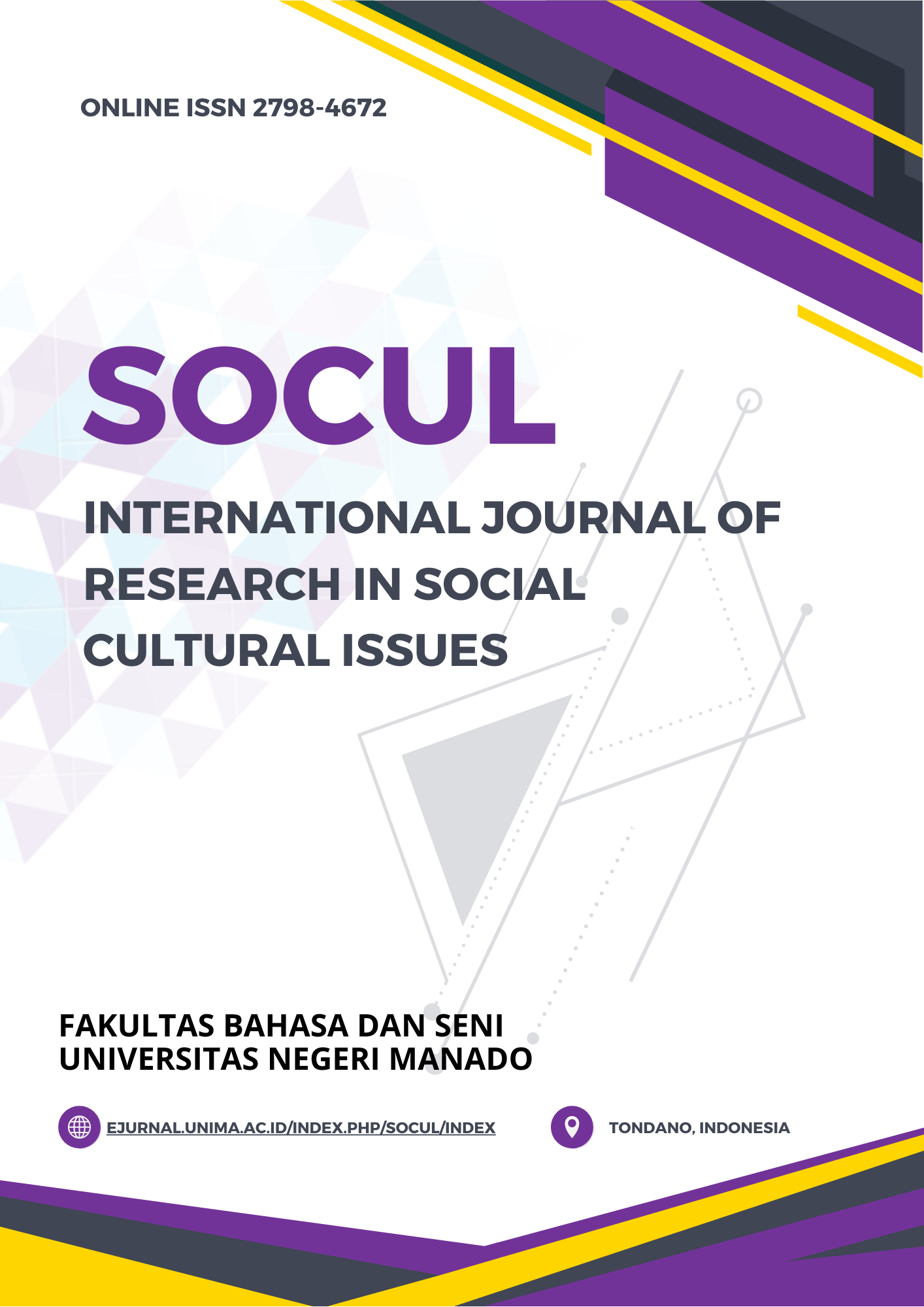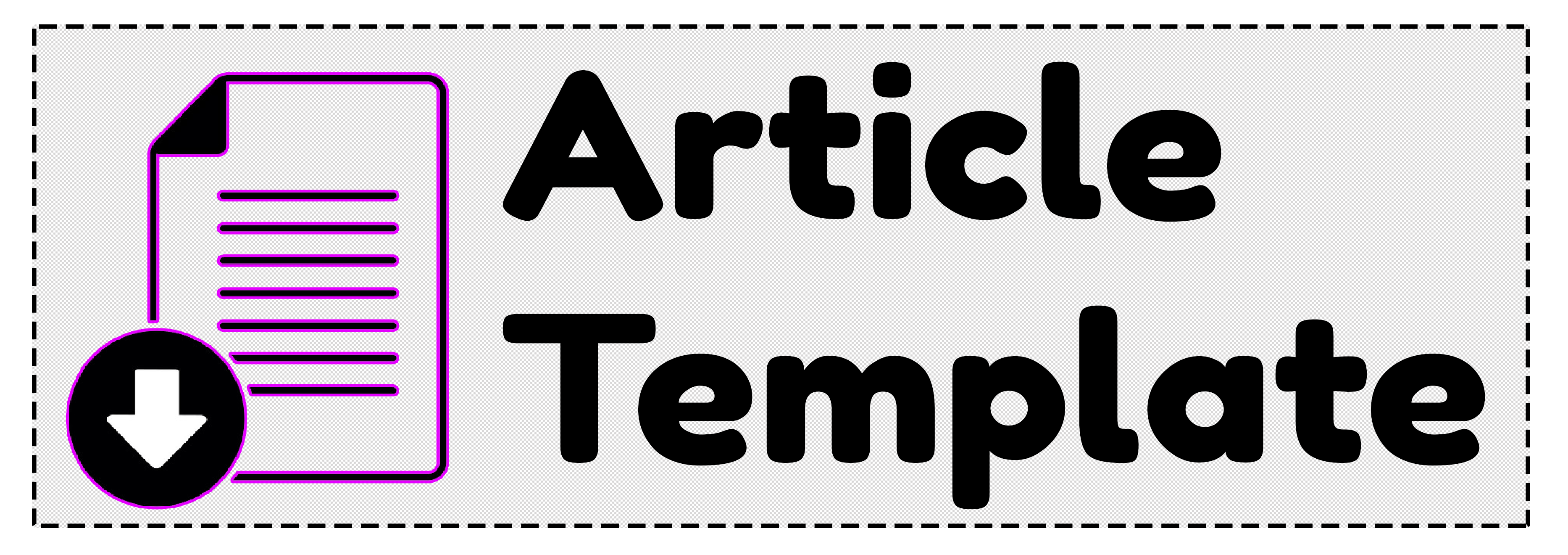THE ANALYSIS OF STUDENTS' LEARNING DIFFICULTIES IN READING COMPREHENSION
A CASE STUDY AT SMP NEGERI 3 KOMBI
DOI:
https://doi.org/10.53682/soculijrccsscli.v3i4.11645Keywords:
Learning Difficulties, Reading Comprehension, Reading Difficulties, English Language LearningAbstract
Reading is one of the most used activities in English Language Learning (ELL), however many students struggle with reading skill in English classroom. The present study aims at investigating the learning difficulties faced by students in reading text and the factors contributing to the learning difficulties. The study conducted at SMP Negeri 3 Kombi employs qualitative method with case study design. Eight 9th-grade students are chosen as the sample of the study using purposive sampling. Data collected from documentation and interview are analyzed through the 3 steps of qualitative data analysis namely data condensation, data display and drawing and verifying conclusion. The findings showed that 9th grade students at SMP Negeri 3 Kombi faced learning difficulties in reading recount text. The learning difficulties they faced are vocabulary (55%), making inference (45%), determining main idea and finding detailed information (35%). Factors such as limited vocabulary, fluency, familiarity with the subject matter and ineffective reading strategies contribute significantly to students reading difficulties. Other factors such as weak verbal reasoning, level of difficulty, and information retention also contribute to the reading difficulties faced by the students. This study suggests that teachers need to use various strategies to tackle the reading difficulties faced by the students.
References
Alderson, J. C. (2010). Assessing Reading. Cambridge: Cambridge University Press.
Al-Jarrah, H., & Ismail, N. S. B. (2018). Reading comprehension difficulties among EFL learners in higher learning institutions. International Journal of English Linguistics, 8(7), 32-41. https://doi.org/10.5539/ijel.v8n7p32.
Amendum, S. J., Conradi, K., & Hiebert, E. (2018). Does text complexity matter in the elementary grades? A research synthesis of text difficulty and elementary students’ reading fluency and comprehension. Educational Psychology Review, 30, 121-151.
Anderson, R. C., Spiro, R. J., & Anderson, M. C. (1978). Schemata as scaffolding for the representation of information in connected discourse. American Educational Research Journal, 15(3), 433-440. https://doi.org/10.3102/00028312015003433.
Andries, F., Hammp, P., Rombepajung, P., & Lengkoan, F. (2019, November). The Application of Special Self-Made Word Card for Vocabulary Teaching Particularly Irregular Verbs. In International Conference on Social Science 2019 (ICSS 2019) (pp. 969-971). Atlantis Press. https://doi.org/10.2991/icss-19.2019.47.
Anthony, E. M. (2022). Reading Comprehension Strategies: A Narrative Review. Development in Language Studies, 2(2), 1-11.
Arikunto, S. 2010. Prosedur Penelitian Suatu Pendekatan Praktik. Jakarta: Rineka Cipta.
Bahmani, R., & Farvardin, M. T. (2017). Effects of Different Text Difficulty Levels on EFL Learners' Foreign Language Reading Anxiety and Reading Comprehension. Reading in a foreign language, 29(2), 185-202.
Baiti, I. U., & Sofa, E. M. (2023). Indonesian and Egyptian EFL university students’ difficulties in reading comprehension. Erudita: Journal of English Language Teaching, 3(1), 81-92. https://doi.org/10.28918/erudita.v3i1.7029.
Balqis, M. N. (2022). Students’ Difficulties in Reading Comprehension. English LAnguage Study and TEaching, 3(1), 18-24.
Banditvilai, C. (2020). The effectiveness of reading strategies on reading comprehension. International Journal of Social Science and Humanity, 10(2), 46-50.
Bowen, G. A. (2009). Document analysis as a qualitative research method. Qualitative research journal, 9(2), 27-40.
Brooks, G., Clenton, J., & Fraser, S. (2023). Exploring the Importance of vocabulary for English as an additional language learners' reading comprehension. In EAL Research for the Classroom (pp. 35-58). Routledge.
Chen, S. C. & Chen, K. T. (2015). The use of EFL reading strategies among high school students in Taiwan. The reading matrix, 15(2),156 - 166. Retrieved from https://readingmatrix.com/files/13.pdf.
Chiang, M. H. (2016). Effects of varying text difficulty levels on second language (L2) reading attitudes and reading comprehension. Journal of Research in Reading, 39(4), 448-468.
Chin, C. S. (2002). Context, semantic mapping, and word lists: Effectiveness on EFL learners’ vocabulary growth. English Teaching, 57(4), 245-266.
Chou, P. T. M. (2011). The effects of vocabulary knowledge and background knowledge on reading comprehension of Taiwanese EFL students. Electronic Journal of Foreign Language Teaching, 8(1).
Daneman, M., & Tardif, T. (2016). Working memory and reading skill re-examined. In Attention and performance XII (pp. 491-508). Routledge.
Dila, P. W. (2024). An Analysis of Students’ Difficulties in Reading Comprehension At The First Semester of The Tenth Grade Students of SMK Negeri 1 Natar in The Academic Year of 2023/2024 (Doctoral dissertation, UIN Raden Intan Lampung).
Fadhilla, N., Chandra, C., & Wijanarko, T. (2024). Analisis Kesulitan Membaca Pemahaman Siswa Kelas IV Sekolah Dasar Sulit Air. TSAQOFAH, 4(4), 3172-3180. https://doi.org/10.58578/tsaqofah.v4i4.3217.
Fahriany. (2014). Schema theory in reading class. IJEE (Indonesian Journal of English Education), 1 (1), 17 – 21. http://dx.doi.org/10.19166/dil.v5i1.6567
Frans, S. A., Ani, Y., & Wijaya, Y. A. (2023). Kemampuan Membaca Pemahaman Siswa Sekolah Dasar [Reading Comprehension Skills of Elementary School Students]. Diligentia: Journal of Theology and Christian Education, 5(1), 54-68.
Grabe, W., & Stoller, F. L. (2013). Teaching and researching reading. Routledge.
Graham, L., & Bellert, A. (2005). Reading comprehension difficulties experienced by students with learning disabilities. Australian Journal of Learning Difficulties, 10(2), 71-78. https://doi.org/10.1080/19404150509546791.
Gundrum, D. A. (2022). Uniqbu journal of social sciences (ujss) vol.3 no.2. 3(2). https://doi.org/10.31219/osf.io/hwrjp
Harvey, S., & Goudvis, A. (2007). Strategies that work: Teaching comprehension for understanding and engagement. Stenhouse publishers.
Hossain, K. I. (2024). Reviewing the role of culture in English language learning: Challenges and opportunities for educators. Social Sciences & Humanities Open, 9, 100781. https://doi.org/10.1016/j.ssaho.2023.100781.
Intan, S. (2022). An Analysis of Students’ Difficulties in Comprehending English Reading Exercises at The Eleventh Grade of MA Ma’arif Nu 02 Sidorejo in The Academic Year 2021/2022 (Doctoral dissertation, UIN Raden Intan Lampung).
Jamali Kivi, P., Namaziandost, E., Fakhri Alamdari, E., Ryafikovna Saenko, N., Inga-Arias, M., Fuster-Guillén, D., ... & Nasirin, C. (2021). The comparative effects of teacher versus peer-scaffolding on EFL learners’ incidental vocabulary learning and reading comprehension: A socio-cultural perspective. Journal of psycholinguistic research, 50, 1031-1047.
Jaroslawska, A. J., Gathercole, S. E., Allen, R. J., & Holmes, J. (2016). Following instructions from working memory: Why does action at encoding and recall help?. Memory & Cognition, 44, 1183-1191.
Jin, T., Jiang, Y., Gu, M. M., & Chen, J. (2022). “Their encouragement makes me feel more confidentâ€: Exploring peer effects on learner engagement in collaborative reading of academic texts. Journal of English for Academic Purposes, 60, 101177. https://doi.org/10.1016/j.jeap.2022.101177.
Joh, J., & Schallert, D. L. (2014). How conception of task influences approaches to reading: A study of Korean college students recalling an English text. TESOL Quarterly, 48(4), 715-737.
Kim, Y. S. G., Quinn, J. M., & Petscher, Y. (2021). What is text reading fluency and is it a predictor or an outcome of reading comprehension? A longitudinal investigation. Developmental psychology, 57(5), 718.
Klauda, S. L., & Guthrie, J. T. (2008). Relationships of three components of reading fluency to reading comprehension. Journal of Educational psychology, 100(2), 310.
Küçükoğlu, H. (2013). Improving reading skills through effective reading strategies. Procedia-Social and Behavioral Sciences, 70, 709-714.
Larasati, D. (2019). An Analysis of Difficulties in Comprehending English Reading Text at the Eleventh Grade Students of MA LAB UIN-SU Medan (Doctoral dissertation, Universitas Islam Negeri Sumatera Utara).
Lee, S. A. (2022). The Philosophy of ESL: A Literature Analysis on the State of English as a Foreign Language. Open Access Library Journal, 9(10), 1-10. https://doi.org/10.4236/oalib.1109350.
Lei, S. A., Rhinehart, P. J., Howard, H. A., & Cho, J. K. (2010). Strategies for improving reading comprehension among college students. Reading Improvement, 47(1), 30-43.
Lestari, R. P., Fitriani, S. S., & Erdiana, N. (2017). Reading comprehension difficulties encountered by senior high school EFL students. Research in English and Education Journal, 2(2), 110-118.
Lestari, T., Muljanto, S., & Hamzah, A. (2020). An Analysis of Students' Difficulties in Reading Comprehension. English Education and Applied Linguistics Journal (EEAL Journal), 3(1), 43-49. http://dx.doi.org/10.31980/eealjournal.v3i1.1095.
Liando, N. V. F., Tatipang, D. P., Tamboto, G., Poluan, M., & Manuas, M. (2022). Pictures as a learning media in teaching vocabulary. Jurnal Ilmiah Universitas Batanghari Jambi, 22(3), 1944-1949. http://dx.doi.org/10.33087/jiubj.v22i3.2832.
Lubis, S. N., & Dwinata, E. (2024). ANALYSIS OF THE SEVENTH GRADE STUDENTS’DIFFICULTIES FACTOR IN READING COMPREHENSION AT SMPN 1 CAMPURDARAT. Journal of English Teaching and Linguistics Studies (JET Li), 6(1), 1-9.
Marlinton, M., Syahri, I., & Mayasari, S. (2023). The Efficacy of Task-Based Learning and Learning Motivation on Student’s Reading Comprehension: A Wholistic Study. Elsya: Journal of English Language Studies, 5(2), 250-269. https://doi.org/10.31849/elsya.v5i2.14082.
Maru, M. G., Paranduk, R., Tuerah, J. (2021) Readability Level of English Reading Text Used in The Era of Pandemic. Syntax Literate: Jurnal Ilmiah Indonesia. 6(7). http://dx.doi.org/10.36418/syntaxliterate.v6i7.3557.
Masduqi, H. (2016). Integrating receptive skills and productive skills into a reading lesson. In Proceeding of the International Conference on Teacher Training and Education (No. 1, pp. 507-511).
Miles, M. B., Huberman, A. M., & Saldana, J. (2014). Qualitative data analysis: A methods sourcebook (3rd edition). Sage Publications, Inc.
Moghadam, S.H., Zainal, Z. & Ghaderpour, M. (2012). A review on the important role of vocabulary knowledge in reading comprehension performance. Procedia Social and Behavioural Sciences, 66, 555 563. https://doi.org/10.1016/j.sbspro.2012.11.300.
Nanda, D. W., & Azmy, K. (2020). Poor reading comprehension issue in EFL classroom among Indonesian secondary school students: Scrutinizing the causes, impacts and possible solutions. Englisia: Journal of Language, Education, and Humanities, 8(1), 12-24. http://dx.doi.org/10.22373/ej.v8i1.6771.
Nurjanah, R. L. (2018). The analysis on students’ difficulties in doing reading comprehension final test. Metathesis: journal of English language, literature, and teaching, 2(2), 253-264.
Nurmalasari, N., & Haryudin, A. (2021). The Students’ Difficulties in Learning Reading. PROJECT (Professional Journal of English Education), 4(1), 29-34. https://doi.org/10.22460/project.v4i1.p29-34.
Nuttall, C. (2000). Teaching reading skills in a foreign language. Oxford: Macmillan.
Oakhill, J., Cain, K., & Elbro, C. (2014). Understanding and teaching reading comprehension: A handbook. Routledge.
Pabur, H. E., Ismail., Ali, M. I., & Tatipang, D. P. (2023). The Use of Literature in English as a Foreign Language Teaching and Learning Process: The Relationship and Suggested Techniques to be Used in EFL Classrooms. Edumaspul: Jurnal Pendidikan, 7(2), 2660-2670. https://doi.org/10.33487/edumaspul.v7i2.6159.
Peng, P., Barnes, M., Wang, C., Wang, W., Li, S., Swanson, H. L., ... & Tao, S. (2018). A meta-analysis on the relation between reading and working memory. Psychological bulletin, 144(1), 48.
Pranoto, E. S. A. (2021). AN ANALYSIS OF STUDENTS’DIFFICULTIES IN READING COMPREHENSION THROUGH GOOGLE DOCS. EDUTAMA.
Rahmani, M., & Sadeghi, K. (2011). Effects of note-taking training on reading comprehension and recall. Reading, 11(2), 116-128
Ramadhianti, A., & Somba, S. (2023). Reading comprehension difficulties in Indonesian EFL students. Journal of English Language Teaching and Literature (JELTL), 6(1), 1-11. https://doi.org/10.47080/jeltl.v6i1.2477.
Rasinski, T. (2014). Fluency matters. International electronic Journal of elementary education, 7(1), 3-12. Retrieved from https://iejee.com/index.php/IEJEE/article/view/60.
Sadiku, L. M. (2015). The importance of four skills reading, speaking, writing, listening in a lesson hour. European Journal of Language and Literature, 1(1), 29-31. https://doi.org/10.26417/ejls.v1i1.p29-31.
Safitri, S.D and Budiasih, (2023) Students’ Difficulties In Reading Comprehension At The Eighth Grade Of SMP N 2 Weru In Academic Year 2022/2023. Skripsi thesis, UIN RADEN MAS SAID. Accessed from https://eprints.iain-surakarta.ac.id/id/eprint/6748.
Sapitri, D., & Novia, F. (2020). AN ANALYSIS OF STUDENTS’DIFFICULTIES IN COMPREHENDING NARRATIVE TEXT. Language and Education Journal, 5(2), 103-112.
Saraswati, N. K. R., Dambayana, P. E., & Pratiwi, N. P. A. (2021). An analysis of students’ reading comprehension difficulties of eighth grade students at SMP Negeri 4 Tegalalang. Jurnal IKA, 19(1), 34-45.
Sarica, G. N. & Cavus, N. (2008). Web-Based English Language Learning. Presented at International Educational Technology Conference 2008. Retrieved September 10, 2024 from https://www.learntechlib.org/p/62190/.
Septia, N. W., Indrawati, I., Juriana, J., & Rudini, R. (2022). An analysis of students’ difficulties in reading comprehension. EEdJ: English Education Journal, 2(1), 11-22. https://doi.org/10.32923/eedj.v2i1.2519.
Sharifi, S., & Rezaei, S. (2018). The effectiveness of working memory training on reading difficulties among students with reading disorder. Iranian Journal of learning and memory, 1(1), 43-54.
Siddiek, A. G., & Alfaki, I. M. (2013). The role of background knowledge in enhancing reading comprehension. World Journal of English Language, 3(4).
Smith, R., Snow, P., Serry, T., & Hammond, L. (2021). The role of background knowledge in reading comprehension: A critical review. Reading Psychology, 42(3), 214-240.
Snow, Cetherine. (2002). Reading For Understanding: Toward a Researcher and Development Program in Reading Comprehension. New York: RAND.
Sulung, Y. Y., & Tuerah, I. J. (2021). The Effect of Choral Reading Strategy on Teaching Students Reading Comprehension. SoCul: International Journal of Research in Social Cultural Issues, 1(01), 21-29. https://doi.org/10.53682/soculijrccsscli.v1i01.1696.
Torppa, M., Vasalampi, K., Eklund, K., Sulkunen, S., & Niemi, P. (2020). Reading comprehension difficulty is often distinct from difficulty in reading fluency and accompanied with problems in motivation and school well-being. Educational Psychology, 40(1), 62-81. https://doi.org/10.1080/01443410.2019.1670334.
Trassi, A. P., Oliveira, K. L. D., & Inácio, A. L. M. (2019). Reading comprehension, learning strategies and verbal reasoning: possible relationships. Psico-USF, 24(4), 615-624.
Westwood, P. (2008). What teachers need to know about reading and writing difficulties. ACER Press.
Yin, R. K. (2017). Case study research and applications: Design and methods. Sage publications














